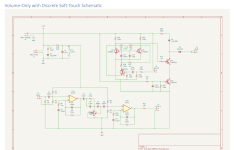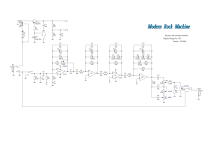You are using an out of date browser. It may not display this or other websites correctly.
You should upgrade or use an alternative browser.
You should upgrade or use an alternative browser.
TPA3118 60W Power Amp Module
- Thread starter falzhobel
- Start date
Paul.Ruby
Active member
It has power-on delay but cannot detect power loss. It has a footswitch to enable/disable, so you are still expected to disable prior to power loss.Hello. Does this circuit prevent popping noises when the amplifier is turned off?
Can I use 12V power for this circuit?
Part of the circuit on the TL072 is a preamp or just a volume control, can I connect other preamps to input (J2)?
The preamplifier has 2 jobs: one is to bring instrument level up to line level for the power amp. Second is a bit of EQ to add some sparkle, just like real guitar preamps with a "bright cap" on the volume or gain pot. See R7, C6, C7 in that schematic. Those can all be tweaked to taste.
Other preamps can be used, of course, as long as they bring the signal up to line level, not instrument level.
Paul.Ruby
Active member
And, yes 12V will work but will only reach about 1/4 of the rated power (assuming you want to use the same 12V for the power amp).Hello. Does this circuit prevent popping noises when the amplifier is turned off?
Can I use 12V power for this circuit?
Part of the circuit on the TL072 is a preamp or just a volume control, can I connect other preamps to input (J2)?
Lesnik
New member
Thanks for the answer. I'm going to use these two preamps. They are powered by 9 volts, but I tried 12 volts and did not hear any changes, so I decided to power everything from 12 volts in order not to complicate the circuit and save space on the printed circuit board.It has power-on delay but cannot detect power loss. It has a footswitch to enable/disable, so you are still expected to disable prior to power loss.
The preamplifier has 2 jobs: one is to bring instrument level up to line level for the power amp. Second is a bit of EQ to add some sparkle, just like real guitar preamps with a "bright cap" on the volume or gain pot. See R7, C6, C7 in that schematic. Those can all be tweaked to taste.
Other preamps can be used, of course, as long as they bring the signal up to line level, not instrument level.
Attachments
Elijah-Baley
Active member
At 12v you should get more clear and less gainy sound, more "headroom". But with just 3v maybe you can't hear difference.
I seen before the Modern Rock Machine schematic, it looks very interesting. I never tried it, and I never found any demo, but I'm curious to hear it. Could you let us listen something about it, please?
I seen before the Modern Rock Machine schematic, it looks very interesting. I never tried it, and I never found any demo, but I'm curious to hear it. Could you let us listen something about it, please?
Lesnik
New member
Hello, here are samples of MRM and other schemes of the author.

 guitar-gear.ru
guitar-gear.ru

Archaic Rock Machine
Вот лазишь, лазишь по забугорным сайтам, ищешь бутиковые схемы, а тут если посмотреть свои форумы отличные примочки есть! В общем первый раз схе...
Elijah-Baley
Active member
Thank you.
That, and other high gain circuit in that thread, seems sound a bit rude, as if it needs a cabinet simulator.
Do you find your build sounds like in the demo?
That, and other high gain circuit in that thread, seems sound a bit rude, as if it needs a cabinet simulator.
Do you find your build sounds like in the demo?
internalevidence
New member
Hi everyone,
I'm new to the forum and recently finished building a power amplifier using a generic module and an old HP power brick (19.5V @ 3.3 Amps). I wanted to share my experience and seek advice on an issue I'm facing.
When the power amp is connected to equipment with an audio ground linked to the mains earth, it works quietly and efficiently. However, when the ground is lifted—such as using a Boss GE-7 as a preamp powered by a battery or isolated linear PSU—I hear high-frequency noise typical of an SMPS.
The noise reduces when I ground the system by touching the guitar strings or bridge, but it's not as effective as using the mains earth. I haven't used the 4700µF capacitor in parallel to positive and ground as suggested, although I tried a 100pF ceramic capacitor with little improvement.
I've attached a photo of the build. Any comments or suggestions would be greatly appreciated!
I'm new to the forum and recently finished building a power amplifier using a generic module and an old HP power brick (19.5V @ 3.3 Amps). I wanted to share my experience and seek advice on an issue I'm facing.
When the power amp is connected to equipment with an audio ground linked to the mains earth, it works quietly and efficiently. However, when the ground is lifted—such as using a Boss GE-7 as a preamp powered by a battery or isolated linear PSU—I hear high-frequency noise typical of an SMPS.
The noise reduces when I ground the system by touching the guitar strings or bridge, but it's not as effective as using the mains earth. I haven't used the 4700µF capacitor in parallel to positive and ground as suggested, although I tried a 100pF ceramic capacitor with little improvement.
I've attached a photo of the build. Any comments or suggestions would be greatly appreciated!
Attachments
Paul.Ruby
Active member
You must have exactly one earth ground connection to the ground (shield) of your guitar rig. Not zero and not two, which makes choice of power supply important. If your 9V power supply is earth grounded and connects the negative rail of it's 9V output to earth ground, then the power supply to your power amp should not be earth grounded. And visa-versa is true as well. One of them with earth ground and the other without. Else, you create a ground loop.Hi everyone,
I'm new to the forum and recently finished building a power amplifier using a generic module and an old HP power brick (19.5V @ 3.3 Amps). I wanted to share my experience and seek advice on an issue I'm facing.
When the power amp is connected to equipment with an audio ground linked to the mains earth, it works quietly and efficiently. However, when the ground is lifted—such as using a Boss GE-7 as a preamp powered by a battery or isolated linear PSU—I hear high-frequency noise typical of an SMPS.
The noise reduces when I ground the system by touching the guitar strings or bridge, but it's not as effective as using the mains earth. I haven't used the 4700µF capacitor in parallel to positive and ground as suggested, although I tried a 100pF ceramic capacitor with little improvement.
I've attached a photo of the build. Any comments or suggestions would be greatly appreciated!
Then this can get more complicated if you are sending signal off to some other equipment like a PA or recording interface.
Paul.Ruby
Active member
By the way, your TPA3118 board is a fake. That's not a TPA3118. Real ones have 32 pins. Yours has 28. I've gotten the same fakes and the fakes have a lot more hiss than real ones but aren't bad sounding.Hi everyone,
I'm new to the forum and recently finished building a power amplifier using a generic module and an old HP power brick (19.5V @ 3.3 Amps). I wanted to share my experience and seek advice on an issue I'm facing.
When the power amp is connected to equipment with an audio ground linked to the mains earth, it works quietly and efficiently. However, when the ground is lifted—such as using a Boss GE-7 as a preamp powered by a battery or isolated linear PSU—I hear high-frequency noise typical of an SMPS.
The noise reduces when I ground the system by touching the guitar strings or bridge, but it's not as effective as using the mains earth. I haven't used the 4700µF capacitor in parallel to positive and ground as suggested, although I tried a 100pF ceramic capacitor with little improvement.
I've attached a photo of the build. Any comments or suggestions would be greatly appreciated!
internalevidence
New member
Hi Paul, as you said, I was able to validate that my psu did not connect the negative rail to earth ground. After taking care of that the ground loop is completely gone. I'll try to open the psu case for a permanent fix and possibly implement a ground lift.You must have exactly one earth ground connection to the ground (shield) of your guitar rig. Not zero and not two, which makes choice of power supply important. If your 9V power supply is earth grounded and connects the negative rail of it's 9V output to earth ground, then the power supply to your power amp should not be earth grounded. And visa-versa is true as well. One of them with earth ground and the other without. Else, you create a ground loop.
Then this can get more complicated if you are sending signal off to some other equipment like a PA or recording interface.
Thank you very much for your help!!
Emanuel
Paul.Ruby
Active member
Cool. This is really important. Most switch mode power supplies, especially cheap ones, do not have sufficient isolation of the mains power and the output. A solid earth ground is the only thing protecting you if there is a failure in any of these power supplies that could short mains to the output. I just did a retrofit on a power supply to add a fuse inline with the hot main and a strong earth ground. I moved the power supply from it's cheap plastic case into a 125B pedal case to do this. It's the 18V power supply to our new Soundcraft Ui12, which, insanely, uses a cheap, ungrounded power brick. We used it once before fixing this and singers were getting shocked on the mics. Really unbelievable death trap.Hi Paul, as you said, I was able to validate that my psu did not connect the negative rail to earth ground. After taking care of that the ground loop is completely gone. I'll try to open the psu case for a permanent fix and possibly implement a ground lift.
Thank you very much for your help!!
Emanuel
Similar threads
- Replies
- 4
- Views
- 196
- Replies
- 15
- Views
- 1K






